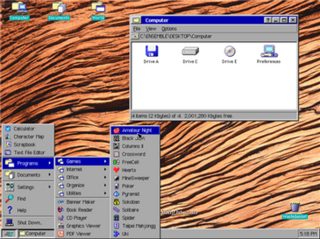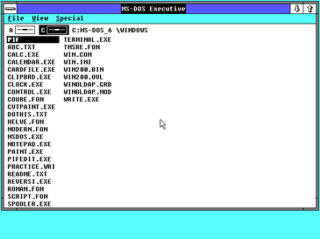Related Research Articles

Lotus 1-2-3 is a discontinued spreadsheet program from Lotus Software. It was the first killer application of the IBM PC, was hugely popular in the 1980s, and significantly contributed to the success of IBM PC-compatibles in the business market.

Microsoft Office, or simply Office, is a discontinued family of client software, server software, and services developed by Microsoft. It was first announced by Bill Gates on August 1, 1988, at COMDEX in Las Vegas. Initially a marketing term for an office suite, the first version of Office contained Microsoft Word, Microsoft Excel, and Microsoft PowerPoint. Over the years, Office applications have grown substantially closer with shared features such as a common spell checker, Object Linking and Embedding data integration and Visual Basic for Applications scripting language. Microsoft also positions Office as a development platform for line-of-business software under the Office Business Applications brand.
Lotus Symphony was an integrated software package for creating and editing text, spreadsheets, charts and other documents on the MS-DOS operating systems. It was released by Lotus Development as a follow-on to its popular spreadsheet program, Lotus 1-2-3, and was produced from 1984–1992. Lotus Jazz on the Apple Macintosh was a sibling product.
Lotus Software was an American software company based in Massachusetts; it was "offloaded" to India's HCL Technologies in 2018.
Quattro Pro is a spreadsheet program developed by Borland and now sold by Corel, most often as part of Corel's WordPerfect Office suite.
Framework, launched in 1984, was an office suite to run on the (x86) IBM PC and compatibles with the MS-DOS operating system.
Wingz was a spreadsheet program sold by Informix in the late 1980s and early 1990s. Originally developed for the Macintosh, it was later ported to Microsoft Windows, OS/2, NeXTSTEP and several other commercial flavors of Unix. In spite of many positive reviews, including one calling it "clearly the spreadsheet of the future", the market was rapidly entrenching Microsoft Excel. Informix eventually gave up on the desktop market and reverted solely to database sales in the mid-1990s. Claris licensed and sold an extensively cleaned up version as Claris Resolve in 1991, but it was far too late to market to have any effect.

GEOS is a computer operating environment, graphical user interface (GUI), and suite of application software. Originally released as PC/GEOS, it runs on DOS-based, IBM PC compatible computers. Versions for some handheld platforms were also released and licensed to some companies.

Harvard Graphics was a graphics and presentation program for IBM PC compatibles. The first version, titled Harvard Presentation Graphics was released for MS-DOS in 1986 by Software Publishing Corporation (SPC) and achieved a high market share. It was taken off the market in 2017.

PC Tools is a collection of software utilities for DOS developed by Central Point Software.

Lotus Magellan is an MS-DOS desktop search package, conceived and developed by Bill Gross and released in 1989 by Lotus Development Corporation, most famous for Lotus 1-2-3. Lotus sold 500,000 copies of Magellan.
cc:Mail is a discontinued store-and-forward LAN-based email system originally developed on Microsoft's MS-DOS platform by Concentric Systems, Inc. in the 1980s. The company, founded by Robert Plummer, Hubert Lipinski, and Michael Palmer, later changed its name to PCC Systems, Inc., and then to cc:Mail, Inc. At the height of its popularity, cc:Mail had about 14 million users, and won various awards for being the top email software package of the mid-1990s.

pfs:Write was a word processor created by Software Publishing Corporation (SPC) and published in 1983. It was released for IBM PC compatibles and the Apple II. It includes the features common to most word processors of the day, including word wrapping, spell checking, copy and paste, underlining, and boldfacing; and it also a few advanced features, such as mail merge and few others. The product was considerably easier to both learn and use than its more fully featured and expensive competitors: WordPerfect, Microsoft Word, and XyWrite.
Q&A was a database and word processing software program for IBM PC–compatible computers published by Symantec and partners from 1985 to 1998. It was written by a team headed by Symantec founder Dr. Gary Hendrix, Denis Coleman, and Gordon Eubanks.
dtSearch Corp. is a software company which specializes in text retrieval software. It was founded in 1991, and is headquartered in Bethesda, Maryland. Its current range of software includes products for enterprise desktop search, Intranet/Internet spidering and search, and search engines for developers (SDK) to integrate into other software applications.

Windows 2.0 is a major release of Microsoft Windows, a family of graphical operating systems for personal computers developed by Microsoft. It was released to manufacturing on December 9, 1987, as a successor to Windows 1.0.

Windows 3.0 is the third major release of Microsoft Windows, launched in 1990. It features a new graphical user interface (GUI) where applications are represented as clickable icons, as opposed to the list of file names seen in its predecessors. Later updates would expand the software's capabilities, one of which added multimedia support for sound recording and playback, as well as support for CD-ROMs.
Synex Systems Corporation, a subsidiary of Synex International Inc. was formed in 1983 in an effort to develop software for the microcomputer market and was run by Synex International Vice President Murray Hendren until 1992. In 2002, Synex Systems was acquired by privately owned Lasata Software of Perth, Australia. In 2005, Lasata was acquired by UK based Systems Union. In 2007, Systems Union was acquired by privately held Infor Global Solutions, a U.S. company that specializes in enterprise software.
Software Publishing Corporation (SPC) was a Mountain View, California-based manufacturer of business software, originally well known for its "pfs:" series of business software products, it was ultimately best known for its pioneering Harvard Graphics business and presentation graphics program.
References
- 1 2 Mark Fritz (June 1998). "AskSam System' askSam 3.0 Professional". eMedia. pp. 76–77.
- ↑ Pfeifer, Daniel J. (August 1999). "askSam ver 3.0". Journal of the Association for History and Computing. 2. hdl:2027/spo.3310410.0002.215.
- ↑ "New askSam 7 Now Available". 11 August 2008. Retrieved 30 August 2017.
- ↑ Rose, Daniel. "DOS - askSam 5.0a". Daniel's Legacy Computer Collections. Archived from the original on 27 January 2015. Retrieved 30 August 2017.
- ↑ Watt, Peggy (5 May 2005). "First Look: AskSam 6 Offers Database Flexibility". PC World . Retrieved 30 August 2017.
- ↑ "The Searchers". PC Magazine . 12 Mar 1996. Retrieved 30 August 2017.
- ↑ "AskSam Gets Boost to Web". eWeek . 9 April 2001.
- ↑ James Fallows (18 April 2004). "Humans vs. Computers, Again. But There's Help for Our Side". The New York Times .
- ↑ "Meet Logseq, an open-source knowledge management system that 'stores data like a brain'". VentureBeat. 2022-05-05. Retrieved 2022-09-13.
- ↑ "AskSam Alternative for Windows". 2021-10-23. Retrieved 2021-10-23.